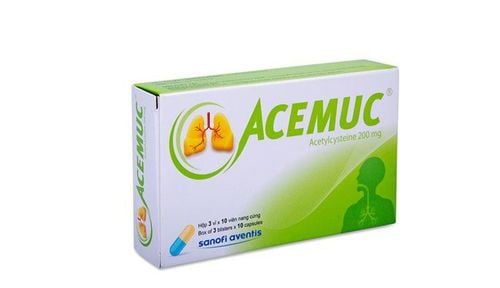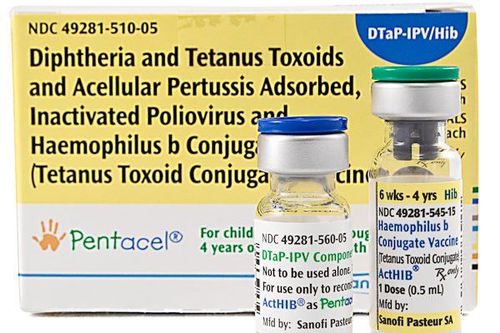This is an automatically translated article.
Atyscine is made in the form of oral syrup, with the main ingredients being Dextromethorphan HBr, Chlorpheniramine maleate and Guaifenesin. The drug is used in the treatment of coughs in colds, bronchitis,...
1. What is Atyscine?
Each 5ml of Atyscine syrup solution contains: 5mg Dextromethorphan HBr, 1.33mg Chlorpheniramine maleate, 50mg Guaifenesin and other excipients. The effects of the main ingredients in the drug are as follows:
Dextromethorphan HBr: Shows direct activity on the cough center in the medulla oblongata, helping to relieve coughs caused by irritants such as colds or stimulants. . Dextromethorphan HBr has the same therapeutic effect as Codeine but has lower toxicity and less gastrointestinal side effects. This ingredient also has no analgesic effect and is less sedating; Chlorpheniramine maleate: An antihistamine that competitively inhibits histamine at its receptors. Since then, this ingredient neutralizes the effect of histamine in the respiratory tract, helping to reduce symptoms of cough and shortness of breath; Guaifenesin: Stimulates the gastric mucosa, promotes airway secretion, increases the volume and thins the mucus inside the lungs. As a result, this ingredient helps to increase the cough reflex and expel sputum. Thus, the drug Atyscine has the effect of cough and expectorant but not addictive.
Indications for the use of Atyscine to stop coughing in the following cases:
Colds, tuberculosis, sore throats; Pneumonia, bronchitis , tracheobronchitis, laryngitis, pneumonia - bronchiolitis; Pertussis , irritated pleura, cough in smokers; Inhalation of irritants. Contraindications to the use of Atyscine drug with the following subjects:
Patients with hypersensitivity, allergy to the active ingredients and components of the drug; The patient is in an acute asthma attack; People with narrow angle glaucoma; Patients with bladder neck obstruction, prostate enlargement; Patients with gastric ulcer, pyloric - duodenal obstruction; Children under 2 years old; Women who are breastfeeding; People who are taking MAO inhibitors.
2. How to use and dosage of Atyscine
How to use: Oral, can be taken before or after meals. The syrup bottle should be shaken well before drinking.
Dosage:
People from 12 years of age and older: Use a dose of 30mg/time, up to 120mg/day; Children from 6 to 12 years old: Use dose 15mg/time, maximum 60mg/day; Children from 2 to 6 years old: Use dose 1.5mg/time, maximum 30mg/day; Dose interval: 6-8 hours. Missed dose: When a dose of Atyscine is forgotten, the patient should take it as soon as he remembers. If it is too close to your next dose, skip the missed dose and continue taking your next dose as usual as originally scheduled. Note, patients should not take double the prescribed dose.
Overdose: When using Atyscine overdose, patients may experience symptoms such as:
Overdose of Dextromethorphan HBr: Nausea, vomiting, hallucinations, drowsiness, blurred vision, convulsions, respiratory failure , urinary retention, ...; Chlorpheniramine maleate overdose: Sedation, convulsions, seizures, central nervous system stimulation, dystonia, apnea, arrhythmia, cardiovascular collapse; Guaifenesin overdose: Nausea, vomiting, kidney stones. When Atyscine poisoning is suspected due to an overdose, it is necessary to take the patient to the nearest hospital for timely and effective examination and treatment.
3. Atyscine side effects
During the use of Atyscine, patients may experience some side effects such as:
Somnolence, fatigue, dizziness, sedation, flushed skin, fast heartbeat, nausea, dry mouth; Uncommon: Urticaria; Rare: External rash. When experiencing signs of side effects of Atyscine, patients should immediately notify their doctor for advice on appropriate treatment.
4. Be careful when using Atyscine
Some notes for patients to keep in mind before and while using Atyscine:
Chlorpheniramine in Atyscine can prevent lateral acetylcholine secretion that can cause dysuria, especially in patients with benign prostatic hyperplasia. prostate, pyloric stenosis, urinary obstruction. In addition, this ingredient also aggravates the condition of myasthenia gravis, so drug users need to be careful; Alcohol and sedatives may increase the CNS depressant effects of the chlorpheniramine component in Atyscine; Use caution when using Atyscine in patients with chronic lung disease, shortness of breath and difficulty breathing because this drug has a risk of causing airway complications, respiratory failure and apnea; For pregnant women, if taking Atyscine in the third trimester (the last 3 months of pregnancy), the chlorpheniramine maleate component in the drug can cause seizures in the newborn. Therefore, only use Atyscine if the benefits and risks have been carefully considered and prescribed by a doctor; Atyscine may be excreted in breast milk and cause adverse reactions in a nursing infant. Therefore, its use in women who are breastfeeding is not recommended. If it is necessary to use it, it is necessary to strictly follow the instructions of the doctor; Atyscine can cause side effects on the central nervous system such as causing distraction, so caution should be exercised when using the drug in drivers, operating machinery.
5. Atyscine drug interactions
Drug interactions can have some effect on the activity/effectiveness of the drug or increase unwanted effects. Therefore, the patient needs to share with the doctor the list of drugs he is taking / recently taking and the diseases they have / are suffering from. At the same time, the patient must not stop taking, start taking, or change the dose of any medicine without the consent of the doctor.
Some of the drug interactions of Atyscine include:
Monoamine oxidase (MAO) inhibitors when used concurrently with Atyscine can increase the incidence of serotonin syndrome, even causing death. Besides, the drug increases side effects such as drowsiness, blurred vision, dizziness, constipation, dry mouth, skin flushing, urinary retention, decreased sweating, tachycardia, palpitations, ... ; Concomitant use of Atyscine with Ethanol or CNS depressants may increase the inhibitory effect on the brain; Quinidine can inhibit the metabolism of the Dextromethorphan HBr component in the liver, leading to increased drug toxicity; Components Chlorpheniramine maleate reduces the metabolism of Phenytoin , may increase the concentration of Phenytoin in the blood and cause toxicity; Guaifenesin and Phenylpropanolamine should be used with caution in patients with diabetes, high blood pressure, prostate cancer, cardiovascular problems, or glaucoma. When prescribed to use Atyscine, the patient should immediately inform the doctor about the drugs, including functional foods they are taking, to be considered and adjusted appropriately. At the same time, patients need to strictly follow the doctor's instructions on how to use and dose to ensure the best cough treatment effect.
Please dial HOTLINE for more information or register for an appointment HERE. Download MyVinmec app to make appointments faster and to manage your bookings easily.













